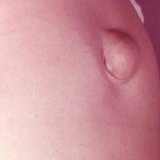Umbilical hernia: methods of treatment in adults

Umbilical hernia is characterized by a condition when the intestine, the large omentum, i.e. Internal organs, extend beyond the front abdominal wall through an opening that is localized in the navel area. Umbilical hernia, methods of treatment in adults are given below, bulging in the region of the umbilical ring, which disappears completely or decreases in size.
Treatment of such a hernia in an adult person necessarily requires surgical intervention. Only sometimes, when the hernia is uncomplicated or there are serious contraindications for the operation( late pregnancy, severe respiratory or cardiovascular diseases, exacerbation of chronic diseases, acute diseases), the operation is not performed, and conservative treatment is prescribed. Conservative treatment consists of wearing a bandage and limiting physical activity. Also, patients who have an umbilical hernia and are obese, are strongly recommended to lose weight.
Treatment methods
Traditional plastic
Such an operation is performed by the methods of Mayo and Sapezhko, plastic is carried out by local tissues. Principle: the edges of the aponeurosis of the navel are sutured in two layers either in the transverse or in the vertical direction. Very often, in this operation, patients are removed from the navel, and in patients with obesity also remove the excess fat apron.
The main disadvantages of the operation:
- large risk of the appearance of a hernia again( at the same place);
- a long period of rehabilitation( physical activity will need to be limited within a year after the operation).
Obstructive hernioplasty method
This is one of the modern methods of treating a hernia in an adult by surgical means.
Operation essence: umbilical hernia is removed through small incisions. At the same time, the hernial bag sets in and the hernial gates are clogged - this is done by an implant( obturation grid).This implant is made of a special material that is not rejected by the body and takes root, which excludes the appearance of a hernia again.
There are two methods for setting the mesh:
- The mesh is placed above the umbilical cord( aponeurosis), directly under the skin. So do in the event that the hernial gate can not be sewn, because they are too big.
- In the second case, the mesh is placed under the umbilical ring. This method is the most optimal. Such an operational method of treatment has no shortcomings.
Advantages:
- low percentage risk of herniation again( less than one percent);
- short rehabilitation period( even for athletes no more than one month);
- can be performed under any kind of anesthesia.
Laparoscopic technique of abdominal hernia removal
To date, this is the newest method of removing such a hernia. This method is low-traumatic and minimally invasive, besides the risk of the appearance of a hernia is again very small.
The operation is carried out under the control of the video camera through small punctures in the abdominal cavity. After such punctures, small inconspicuous scars remain up to 0.5 cm in length.
This method of treatment combines modern technologies and the professionalism of the surgeon, and therefore is the method of removing the hernia giving the best effect.
A small trauma and short rehabilitation time allow the patient to return to active life in the shortest possible time.
Strangulated hernia in adults
Umbilical hernias of an adult have a tendency to infringe. The longer a hernia exists, the more factors there are for complications to arise. Any hernia can be impaired, regardless of size. The operations that are performed with such a hernia are performed using the Sapezhko or Mayo method. In this case, the hernial sac is dissected, the injured organs are examined, then the necrotic tissues are removed, and then the operation is continued in accordance with the methods described above.
If suppuration of the hernial sac occurs, the Grekov method is used: the hernia is completely removed within the healthy tissues. The surgeon enters the abdominal cavity and removes the hernial sac along with the organ that is in it. If there are intestinal loops, this part of the intestine is removed, and anastomosis is placed between the ends( an anastomosis is the connection between the tubular organs).Then spend plastic and sew up a wound.

